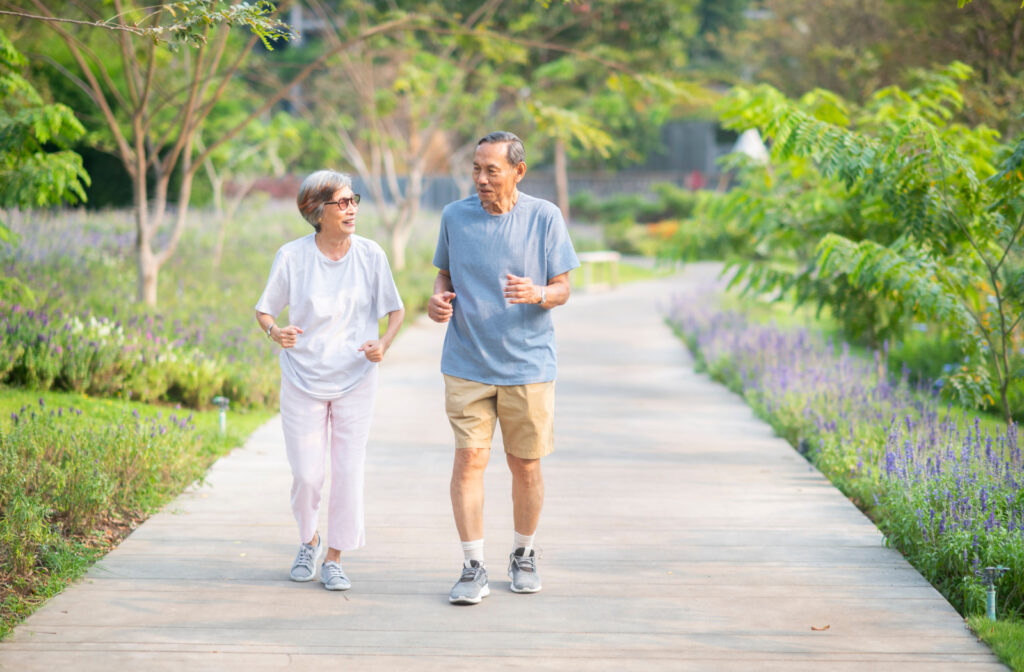As we age, remaining active and engaged helps keep our bodies and minds healthy and strong. While physical activity is crucial for maintaining a healthy lifestyle, it’s equally important to be mindful of your body and choose exercises that promote well-being without risking injury.
Not all exercises are suitable for older adults. To prevent injuries, avoid high-impact and weightlifting exercises, physical activities with twisting or sudden movements, and exercises where falling is a risk.
How Much Exercise Do Seniors Need?
Physical activity can help prevent or delay many health problems as we age. But how much exercise do older adults need?
Some exercise is better than none. However, according to The Centers for Disease Control and Prevention, adults 65 and over need the following amount of physical activity per week:
- At least 150 minutes of moderate-intensity exercise, such as brisk walking.
- At least 2 days of strength training per week.
- Balance exercises at least twice per week.
Exercises to Avoid
The types of exercises you can do depend on your medical history, overall health, and activity level. However, there are some exercises that you may want to avoid due to changes in flexibility, muscular strength, and bone density.
High-Impact Exercises
Cardiovascular exercises are the heartbeat of any fitness routine. However, high-impact activities like running, sprinting, or intense aerobics are not recommended for older adults as these exercises may pose a greater risk of injury and falls.
Instead, opt for low-impact alternatives like brisk walking, swimming, or cycling. These exercises provide much-needed cardiovascular benefits without putting excessive strain on joints.
Weightlifting
Strength training is invaluable for building muscle strength and helps preserve muscle mass and bone density. However, lifting heavy weights can pose a risk to older adults if not executed with proper form.
Avoid using heavy weights and opt for light weights, resistance bands, or bodyweight exercises like squats and lunges. Always prioritize proper form over intensity to prevent strains or injuries. Working with a fitness professional can help tailor a strength training routine that suits your needs and limitations.
Crunches
While core strength is undeniably important, traditional crunches may not be the wisest choice for older adults. The repetitive motion of crunches can strain the neck, back, and spine, potentially worsening health issues like arthritis or osteoporosis.
Instead, opt for safer alternatives like planks and seated leg lifts. These exercises engage the abdominal muscles without subjecting the spine to unnecessary stress.
Behind-the-Neck Exercises
Behind-the-neck exercises, such as presses or pull-downs, can be particularly problematic for older adults. These movements place the shoulders in a vulnerable position, potentially leading to strain or injury, especially for those with pre-existing shoulder issues.
Opt for front-facing exercises that engage your shoulders without compromising their natural range of motion.
Exercises with Extensive Twisting
Twisting can put unnecessary stress on the spine and be more harmful than helpful to older adults, especially those with existing back problems. Exercises that require extensive twisting can include yoga. Instead of traditional yoga, try a moderated variation like chair yoga, which is more gentle and manageable.
Exercises for Older Adults
Exercises that are safer for older adults include:
- Walking
- Stationary bikes
- Elliptical machine
- Aquatic exercises
- Balance exercises
- Resistance band exercises
How to Get Started
While exercise supports mental and physical well-being and can help you maintain your independence longer, it’s always advisable to consult your healthcare professional before starting any new exercise routine.
When you start any exercise regime, begin slowly at your current fitness level and work up. Pushing past your physical ability too quickly can lead to injury. Here are some tips for exercising safely:
- Start with low-intensity exercises.
- Always warm up before and cool down after exercising.
- Pay attention to outdoor surroundings when exercising outside.
- Stay hydrated before, during, and after exercising.
- Wear appropriate clothes and shoes when exercising.
- Speak to your healthcare provider about exercising if you have specific health conditions.
Comprehensive Support for Seniors
Age should not be a deterrent to staying active and fit. The goal is not to avoid exercise when you’re older but to choose activities and exercises that nurture and protect your body throughout your golden years.
Avoid activities that can cause injuries and falls and opt for moderated exercises prioritizing joint health, cardiovascular well-being, and overall mobility.
If you’re looking for a community that will foster and support your physical well-being, contact us or book a tour to see The Legacy at Crystal Falls. We offer a range of services and amenities to improve your quality of life.


